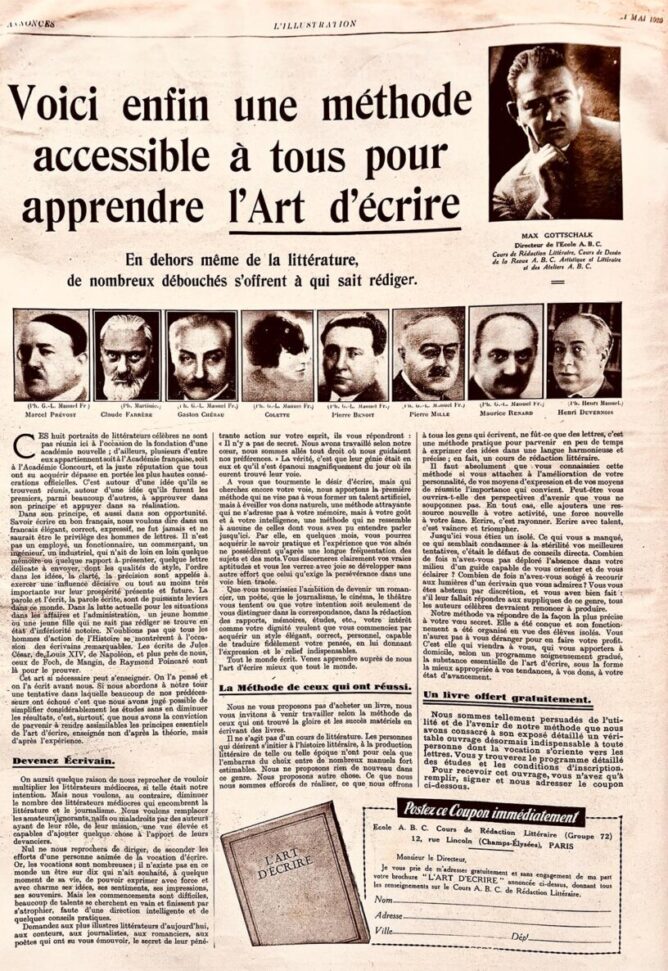The Art & Literature review L’illustration carried a full-page ad in their May 1929 issue that attempted to dispel the myth of genius and the place it occupied in the creation of literary greats. In the absence of genius, they claimed that “This art, if necessary, can be taught”. Black and white portraits of Marcel Prévost, Colette, Henri Duvernois, and others loom above the text, appearing to lend their weight to the claim, while presumably representing the genius that is not, in fact, a requirement for entry into the profession.
Today, bookshelves can be filled several times over with methods that analyse, break-down and provide templates for budding writers, but in the late 1920s when the young Orwell (still Eric Blair at this point) made his way to the French capital, he did so in order to acquire the knowledge and skill set that was not readily available to him elsewhere. His claim at the beginning of Down and Out in Paris and London, that he came to Paris to write novels would be more accurate if he’d said that he came to Paris to learn how to write novels.
The 1929 advertisement for the writing course talks of the isolation of the student writer and of their need for advice. In the absence of a mentor or literary guide, the only way to learn how to write in the early 20th century was by analysing books, rubbing shoulders with other would-be-writers and soaking up as many life experiences as possible. As generations of aspiring artists had done before him, Eric Blair decided that Paris was the required destination.
Whatever his reasons for subsequently destroying the two novels he wrote during his 19 months in Paris, the act of writing them (and of re-reading them) was undoubtedly an invaluable, if brutal indication of where he was at as a writer and of just how far he still had to go. Given his subsequent extreme course of action, the truth, as he perceived it, was evidently devastating. In a letter dated 1938, F.Scott Fitzgerald, himself a long-time Paris resident, critiques a short story sent to him by a friend of the family and tells the aspiring writer that “…the price for doing professional work is a good deal higher than you are prepared to pay at the moment.” before going on to say that “When you have none of the technique which it takes time to learn, you’ve got to sell your heart, your strongest reactions…you have only your emotions to sell.”
Though this advice was unavailable and would have come too late for Eric whilst writing Down and Out, the stylistic path he chose would appear to indicate that he himself came to a similar conclusion; in the absence of the literary skills needed to write novels he was happy with, he would lay down his raw vision of Paris life. Imperfections of style and rough edges would lie alongside those of Paris itself. For the moment at least, and through necessity, emotions would trump style.
Duncan Roberts
Sources:
L’illustration magazine, May 1929
F.Scott Fitzgerald: A Life in Letters
The real people & places from Down and Out in Paris and London are revealed in the forthcoming book, Orwell in Paris – Down & Out with the Russian Captain.
To be published first in French: Orwell à Paris – Dans la dèche avec le capitaine russe. By EXILS éditions, Paris on the 23/04/2024
Share this:
Tags: 1928, 1929, Colette, down and out, Duvernois, Fitzgerald, genius, L'illustration, orwell, paris, Prévost
